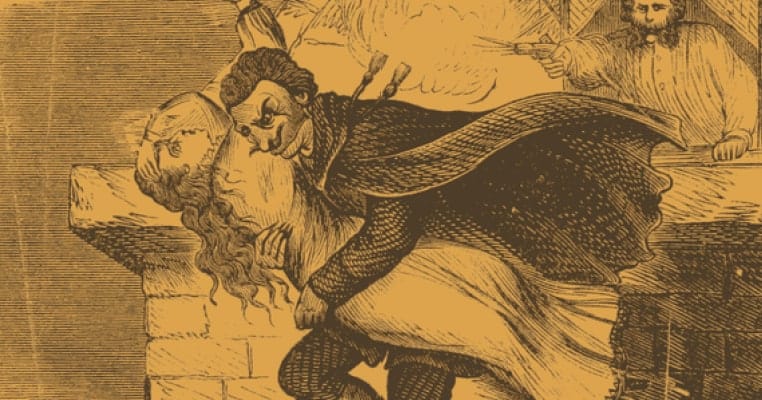In 1837 terrifying tales of a “devil-like gentleman” or “leaping man” began to spring up in the villages around London. The frightening figure appeared to have an unnatural appearance and equally inexplicable abilities. Soon, his antics spread to London itself and the press coined a name for him: Spring Heeled Jack.
Manifestations of Spring Heeled Jack slowly spread from London around the country. They continued until 1904, after which the semi-mythical figure mysteriously disappeared. However, Jack remained very much a part of the popular imagination, appearing in fictional stories, plays, and later films -even lending his name to an infamous murderer- all because of the terror his story generated. Here are just sixteen details that illustrated precisely how and why the story of Spring-Heeled Jack was so frightening.

16. Women appeared to have been the particular Prey of Spring Heeled Jack.
Spring Heeled Jack is rumored to have first appeared on the outskirts of London in October 1837. In 1928, Elizabeth Villiers told the tale of a servant girl, Mary Stevens. Mary was returning to her post in a house in Lavender Hill after a visit to her parents in Battersea. She was walking alone over Clapham Common when a strange figure leaped at her out of a dark alley. Gripping her tightly in his arms, her assailant began to kiss her face and ripped her clothes. Fortunately, Mary’s screams brought help, and her attacker fled.
The next day, the mysterious attacker struck again, this time causing a carriage to crash and injuring the coachman. Several witnesses said they saw the man escape by leaping over a 9ft wall- laughing manically as he did so. On the whole, however, Spring Heeled Jack stuck to terrorizing women. In October 1837, he assaulted a Blackheath barmaid named Polly Adams at a local fair. Polly reported how her attacker tore off her blouse and scratched her stomach with his claws before escaping over a fence.
However, it was in February 1838, that Jack hit the headlines when he began to attack the middle classes. “OUTRAGE ON A YOUNG LADY” screamed The Times on February 11th. The paper carried the story of eighteen-year-old gentleman’s daughter Jane Alsop who had been attacked two days earlier near her home between the villages of Bow and Old Ford. Jane’s attacker caught her by the neck and clothing, forced her head under his arm and tore her dress and hair before she managed to escape and run for her home where her screams eventually raised help from the household.
By March Spring Heeled Jack had moved into London itself. The Morning Post reported the story of his next victim on March 7, 1838. On February 28th, eighteen-year-old Lucy Scales was walking home with her sister after visiting her brother in the Limehouse area of east London. Part of their journey home took them down a passage called Green Dragon Alley. Lucy was in the lead when she noticed a figure lurking in the shadows. Before she could retrace her steps, the figure sprang and attacked her with “a quantity of blue flame” that left her unconscious. Meanwhile, her sister’s screams alerted their brother, and the attacker fled into the night.

